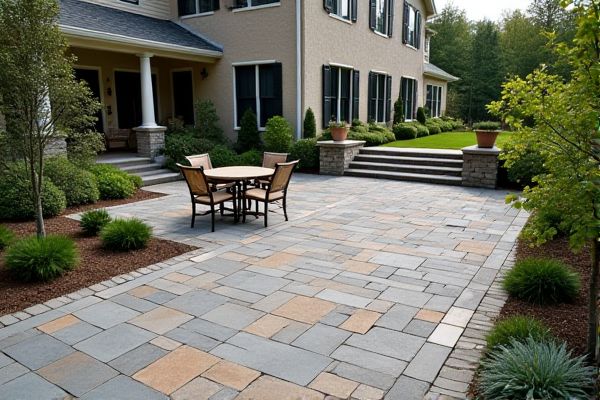
Natural stone patios offer a timeless, organic appearance with unique textures and colors that seamlessly blend into outdoor environments, while paver patios provide versatile design options, uniformity, and ease of installation with varied shapes and patterns. Discover how to choose the ideal material for your outdoor space by exploring the key differences and benefits outlined in the rest of this article.
Table of Comparison
| Feature | Natural Stone Patio | Paver Patio |
|---|---|---|
| Material Composition | Natural stone (granite, slate, limestone) | Concrete or clay pavers |
| Durability | High; weather and wear-resistant | High; resistant to cracking and shifting |
| Design Flexibility | Unique, organic shapes and colors | Variety of shapes, colors, and patterns |
| Installation | Labor-intensive; requires skill | Faster and easier; modular system |
| Maintenance | Low; occasional sealing | Moderate; weed control and joint refilling |
| Cost | Higher upfront cost | Moderate to low cost |
| Lifespan | 30+ years with proper care | 20-30 years depending on quality |
| Environmental Impact | Natural and sustainable | Manufactured; varies by material |
Introduction to Patio Materials
Natural stone patios offer unparalleled durability and a timeless aesthetic, featuring materials like granite, slate, and flagstone that provide unique textures and colors. Paver patios use manufactured concrete or clay blocks, allowing for versatile designs, easier installation, and cost-effective maintenance. Both options enhance outdoor living spaces but differ in longevity, customization, and overall appearance.
Overview of Natural Stone Patios
Natural stone patios feature high-quality materials like granite, slate, and flagstone known for durability, unique textures, and natural color variations. These patios offer superior strength and weather resistance compared to traditional pavers while adding a timeless, organic aesthetic to outdoor spaces. Installation often requires skilled craftsmanship to fit irregular shapes, enhancing visual appeal and long-term value.
Pros and Cons of Natural Stone
Natural stone patios offer unmatched durability and timeless beauty, with materials like slate, granite, and limestone providing natural variations that enhance outdoor aesthetics. They require minimal maintenance and resist fading, cracking, and staining, but installation costs can be higher due to the need for professional fitting and heavier stone weight. Despite a higher upfront investment, natural stone patios increase property value and blend seamlessly with various landscaping styles, making them a long-lasting outdoor flooring choice.
What Are Paver Patios?
Paver patios consist of individual stone, brick, or concrete units arranged in patterns to create durable, customizable outdoor surfaces. Unlike natural stone patios, which use large, irregularly shaped slabs, paver patios offer uniformity and ease of installation or repair due to the modular design. Your choice of paver patios allows for a tailored aesthetic with greater flexibility in shapes and colors, enhancing outdoor living spaces with practical appeal.
Advantages and Drawbacks of Pavers
Paver patios offer advantages such as easy installation, versatility in design, and excellent drainage due to gaps between pavers, reducing water pooling. The durability of pavers allows for simple repairs and replacements without disturbing the entire surface, making maintenance cost-effective. However, pavers may shift over time if not properly installed on a stable base, and weed growth or sand erosion between joints can require periodic upkeep.
Cost Comparison: Natural Stone vs Pavers
Natural stone patios generally incur higher upfront costs due to material rarity and complex installation requirements, with prices ranging from $15 to $30 per square foot. Paver patios typically cost between $8 and $20 per square foot, as they use manufactured or concrete materials that are easier to install and replace. Long-term maintenance expenses also favor pavers since natural stone may require sealing and specialized repairs to preserve its aesthetic and durability.
Durability and Maintenance Factors
Natural stone patios offer superior durability due to their resistance to weathering, cracks, and fading, making them a long-lasting investment for outdoor spaces. Paver patios provide flexibility and easier repair options since individual pavers can be replaced if damaged, reducing long-term maintenance costs. Both options require sealing to prevent stains and weed growth, but natural stone generally demands less frequent upkeep compared to porous pavers.
Aesthetic Differences and Design Options
Natural stone patios offer timeless elegance with unique textures and colors that vary naturally, creating an organic and sophisticated appearance. Paver patios provide extensive design flexibility through uniform shapes and sizes, allowing intricate patterns and custom layouts tailored to your outdoor space. Choosing between the two depends on your desired aesthetic, durability, and overall design goals for your patio.
Installation Process: Natural Stone vs Paver Patios
Natural stone patios require a meticulous installation process involving precise cutting, leveling, and fitting irregularly shaped stones to create a seamless surface, often demanding more time and skilled labor compared to paver patios. Paver patio installation involves laying uniformly shaped bricks or concrete units on a compacted base with sand joints, enabling quicker assembly and easier repairs or replacements. Your choice between natural stone and paver patios significantly impacts installation complexity, timeline, and labor costs due to these differing methods.
Choosing the Right Patio Material for Your Home
Natural stone patios offer a timeless, durable option that enhances property value with unique textures and colors, ideal for homeowners seeking a high-end aesthetic. Paver patios provide versatility and ease of installation, featuring modular designs that allow for simple repairs and customization to fit various landscape styles. Selecting the right material depends on budget, maintenance preferences, climate conditions, and the desired visual impact to ensure long-lasting enjoyment and functionality.
 homyna.com
homyna.com